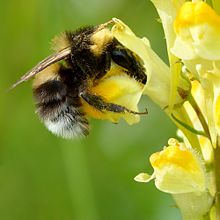Bombus hortorum
| Bombus hortorum | |
|---|---|
 |
|
| Scientific classification | |
| Kingdom: | Animalia |
| Phylum: | Arthropoda |
| Class: | Insecta |
| Order: | Hymenoptera |
| Family: | Apidae |
| Genus: | Bombus |
| Subgenus: | Megabombus |
| Species: | B. hortorum |
| Binomial name | |
|
Bombus hortorum (Linnaeus, 1761) |
|
The garden bumblebee or small garden bumblebee, Bombus hortorum, is a species of bumblebee found in most of Europe north to 70ºN, as well as parts of Asia and New Zealand. It is distinguished from other bumblebees by its long tongue used for feeding on pollen in deep-flowered plants. They have a remarkable visual memory capacity, which aids them in navigating the territory close to their habitat and seeking out food sources. Due to its long tongue, this bumblebee mainly visits flowers with deep corollae, such as deadnettles, ground ivy, vetches, clovers, comfrey, foxglove, and thistles.
Bombus hortorum belongs to the Bombus, or bumblebee, genus. It holds the position of being one of the six most common bumblebees throughout Europe. Of the six species, only two are long-tongued: B. hortorum and B. pascuorum. It is closely related to the species Bombus ruderatus. The two species are nearly identical in terms of morphology, but a DNA sequencing test serves to distinguish them. The test uses electrophoresis-banding patterns to assign identities to the two physically similar species, and taxonomists have discovered an 89-100 percent success rate of accurately recognizing individuals from the two species based on their genetic information.
This bumblebee has an oblong head and a very long tongue, about 15 mm (0.59 in), and in some cases even 20 mm (0.79 in). The tongue is so long that the bee often flies with it extended when collecting nectar. The queen is variable in size, with body lengths between 19 and 22 mm (0.75 and 0.87 in), and wing spans from 35 to 38 mm (1.4 to 1.5 in). The workers are almost as large, the larger ones overlapping the smaller queens. Their color is black with a yellow collar, a narrow yellow band on the scutellum, and a third yellow band on terga (abdominal segments) 1 and 2. The tail is white. Darker forms, with little yellow in their fur, are common.
...
Wikipedia
